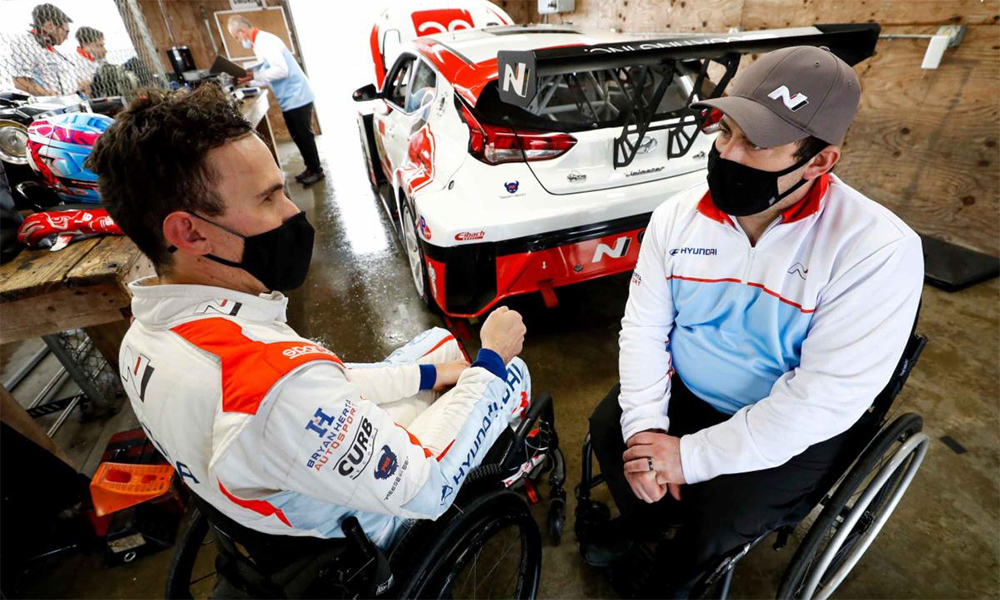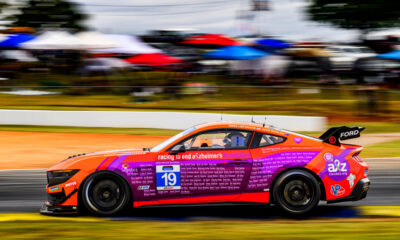
Photo: IMSA
Robert Wickens admitted that he had “a lot of emotions” as he turned his first laps in a race car since sustaining injuries in a NTT IndyCar Series accident nearly three years ago.
The open-wheel ace got behind the wheel of Bryan Herta Autosport’s Hyundai Veloster N TCR at Mid-Ohio on Tuesday for laps in the team’s hand-controlled TCR car that’s used by Michael Johnson (pictured above, right) in IMSA Michelin Pilot Challenge.
Having completed roughly 25 laps in the morning in changing conditions, Wickens said he’s been thankful for the experience offered up by Bryan Herta and Johnson, who is paralyzed from the waist-down.
“It’s been an amazing day so far,” Wickens said Tuesday afternoon during an IMSA-hosted Zoom conference.
“The weather hasn’t been super kind to us. It was a little damp to begin with; it rained overnight and it’s been changeable all day but nevertheless it’s been just a blast.
“I can’t thank Bryan Herta Autosport, Hyundai and Michael Johnson. It’s not every day that someone can lend you a race car to to take an item off your bucket list.
“It’s been it’s been a great day so far.
“There was a lot of emotions once I was able to put my visor down and get back on a race track again.
“The whole week up leading to this… It wasn’t so much nerves.
“There was a lot of excitement and anticipation for this and then once I put a suit on again and started putting in the earpieces, the balaclava, the helmet, it just all went out the window and [felt] like business as usual.
“Once I got back out on track it was a slightly different story.
“Obviously the hand controls that Michael Johnson uses and the Hyundai Veloster is brand new for me, so learning that on a wet track wasn’t without its difficulties.
“We took it step by step and slowly chipped away at getting quicker and quicker.”
Wickens said it’s been a “steep” learning curve in coming to grips with the system, which utilizes a ring on the front of the steering wheel for the throttle and another ring on the back-side for the brakes along with a lever-controlled clutch.
“That’s the hard thing with accessibility is that there’s no textbook on it,” he said.”It’s not like the gas is on the right side and brakes on the left like almost every car in existence.
“There’s been a lot of mental focus that goes into it to pre-plan what I’m doing with my hands before I get to the next corner.
“It’s slowly starting to take shape where I’m having to think less and less about it.”
Return to Racing Dependent on Securing Budget
The 32-year-old Canadian said he has no firm plans beyond today’s test but said he’s open to a future in an “elite” category of motorsports.
“At the moment there’s no real prospects,” Wickens said. “It’s just a great opportunity that Bryan Herta and Hyundai were able to present me with this track day.
“I jumped on the opportunity. I’ve been wanting to drive a race car for a long time now. To finally tick that box is massive in my recovery and my journey back.
“Who knows what the future will bring. I don’t want to get too ahead of myself and just take today for what it is.”
Wickens admitted that a return to racing would require him bringing budget, which has been “pretty tough to get started” so far.
“No one has a crystal ball but first and foremost, getting up and running comes with finance,” he said.
“Unfortunately that’s the motorsports world and that’s what we live in.
“It doesn’t matter if it’s IndyCar, Formula E or IMSA, I think getting up and running with the hand controls I would like to make some small personal changes to better suit maybe what I’d want.
“But at the end of the day, first and foremost, finances is the first hurdle. Once we can get up and running, then we would have the whole world at our disposal.”


























